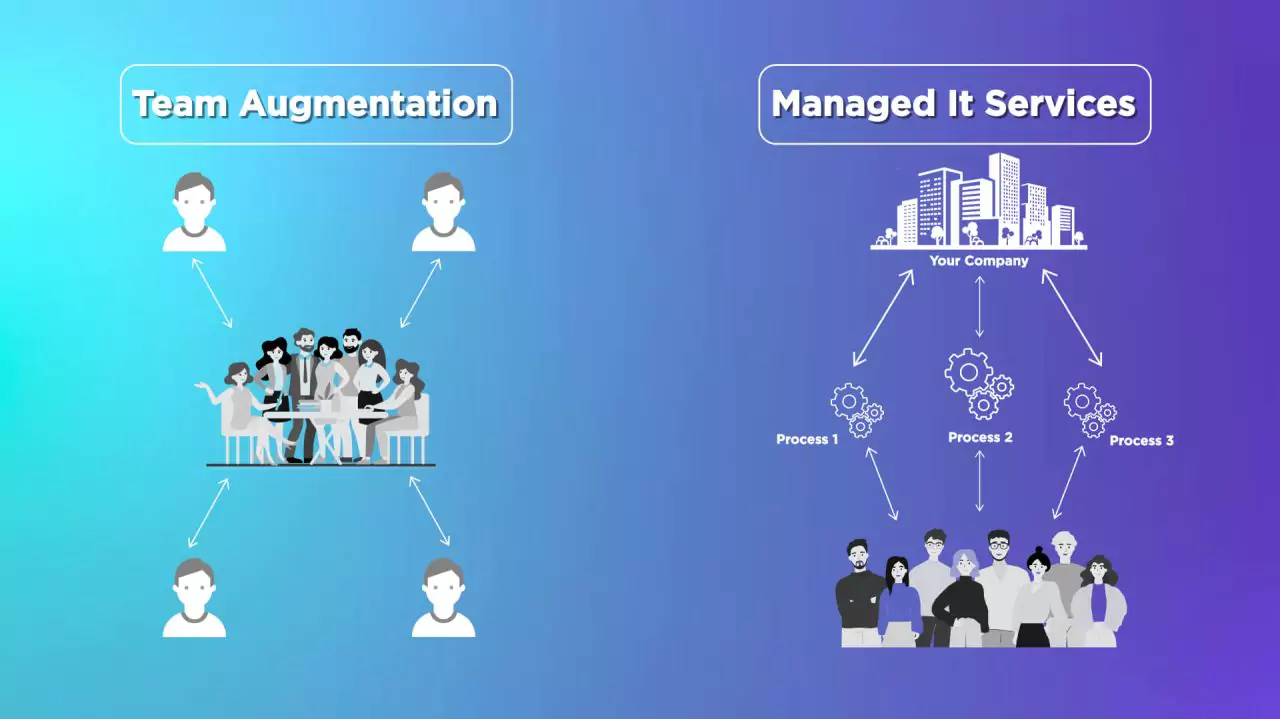More employee recruitment choices are available to firms nowadays. Outsourcing important jobs and project development is popular among enterprises. Different outsourcing models have pros and cons.
This article will discuss staff augmentation and managed services, which are two popular outsourcing methods to firms recently. Which one is better for your firm? Let's compare staff augmentation vs managed services to find the best fit for your firm.
Definition of Staff Augmentation and Managed Services
|
Staff Augmentation |
Managed Services |
|
Supplier agrees to provide resources with a certain level of capability at a price. |
Supplier takes over some or all of the IT execution part. |
|
No service delivery promises based on outputs. |
Service delivery promises are written as "service levels". |
|
Limited commitment. |
Promised scope and term. |
|
Pricing is based on hours worked and availability. |
Pricing is based on service levels and numbers as needed. |
|
The customer oversees the delivery model, including individual suppliers, processes, and tools |
The supplier manages the delivery model, including processes and tools. |
|
There is no change to the way the customer works. |
Affected workers; assets and contracts may be given to a supplier (supplier must buy them or be able to deliver them). |
|
Individual workers are trained and knowledgeable themselves. |
Knowledge must be written down and ready to be shared. |
|
All performance risk stays with the client. |
The supplier takes on the risk of operations and transition. |
|
Promise to provide input. |
Promise to get something done. |
Staff augmentation is when companies temporarily engage outside experts to boost their teams. This strategy addresses specific obstacles, fills talent gaps, meets budget and time constraints, resolves technological issues, and speeds up product release.
On the other hand, managed services involve outsourcing operational responsibilities to a Managed Services Provider. In this arrangement, managed service providers operate independently from the client's IT team. A project proposal with expenses and timing is presented to the client. After approval, they start work and keep the client informed.
Advantages & Disadvantages Comparison: Staff Augmentation VS Managed Services
|
Staff Augmentation |
Managed Services | |
|
Advantages |
|
|
|
Disadvantages |
|
|
Detailed Comparison of Staff Augmentation VS Managed Services
Staff augmentation replaces skill gaps in an organization with temporary workers, whereas managed services outsource IT services to a third-party firm.
|
Staff Augmentation |
Managed Services | |
|
Services |
Involves adding external staff to an organization. Fills skill gaps or adds project resources. Enhanced staff are managed and directed by the organization. |
Outsourcing a full department or function. Planning, execution, and maintenance are handled by the service provider. |
|
Regulation and Supervision |
Clients have full control. Augmented workers work with the client's teams and follow their procedures. |
The service supplier has more freedom. The client sets goals and expectations. The provider decides how to attain them. |
|
Responsibility and Accountability |
The client oversees project success and augmented staff. External staff must perform for the client. |
Managed service providers are responsible for service delivery and success. |
|
Cost Framework |
Based on hours or days worked. |
Has a fixed cost or subscription model. |
|
Length and Adaptability |
Better for the short term. |
Useful for long-term needs. |
|
Proficiency and Specialisation |
The client uses increased staff talents but doesn't demand innovation or strategic change. |
Providers have specialized expertise and must stay current on industry developments and technologies. |
Scope of Service
Outsourcing managed service is a complete function or department to a third-party vendor. The service provider oversees all parts of the business, such as planning, execution, and maintenance. It is a holistic strategy in which the provider bears responsibility for the service's outcomes.
Staff augmentation, on the other hand, refers to the addition of external individuals to an organization's existing workforce. This strategy is generally used to bridge specific skill gaps or add additional project resources. The increased staff report to the organization's administration and leadership.
Regulation and Supervision
Staff augmentation gives organizations additional project control and supervision. Clients can choose tasks and set a deadline to ensure the project fulfills their needs. This management level lets organizations track project progress and adjust to meet goals and deadlines.
In contrast, managed services provide the supplier more control over the project because they must deliver the service agreements. This may require organizations to hand some control to the vendor, changing project management and execution. However, managed services companies have vast knowledge and competence, ensuring that outsourced operations are managed properly.
Responsibility and Accountability
The responsibility for the service's efficacy and successful outcomes lies with the managed service provider. They must ensure that the agreed-upon service levels and performance metrics are met.
The client bears the responsibility for overseeing the augmented personnel and ensuring the overall success of the project. The client holds the external personnel accountable for their performance.
Cost Framework
Since organizations only pay for the time outsourced talent works, staff augmentation might be cheaper for short-term needs. Since staff augmentation is cheaper than managed service provider engagements, this model is ideal for projects or skill gaps that require a few personnel.
For long-term demands, managed services require ongoing investment. Success requires this investment. Managed services may cost more than staff augmentation for short-term initiatives, but they streamline operations, improve security, and provide long-term support and maintenance.
Length and Adaptability
Staff augmentation is more flexible and scalable than managed services. Staff augmentation helps organizations adapt to changing needs by scaling specific functions fast. This is especially useful for firms with workload changes or specific issues that demand specialized talents.
Managed services take a broader approach to IT management, with the provider responsible for meeting service commitments. Managed services can adapt to changing needs, but they lack the flexibility and scalability of personnel augmentation. Businesses must understand the major differences between augmentation and managed services to make educated selections.
Proficiency and Specialisation
For managed services, it's up to providers to keep up with the latest tools and trends in their service area, and they usually have specialized skills.
Meanwhile, the client uses the augmented staff's specific skills but doesn't usually expect them to come up with new ideas or make strategic changes.

When To Use Staff Augmentation?
-
Team members must have particular skills: You may already have a solid team. However, you need specific skills to develop the team and ensure project success.
-
Short deadline: The recruiting procedure takes time and effort to discover suitable candidates. To start a project rapidly with tight deadlines, hire augmented staff.
-
Your budget is limited: Short-term hires with certain talents are generally cheaper for small and medium-sized businesses.
When To Use Managed Services?
-
You desire budget stability: Managed service companies generally provide ongoing maintenance to handle issues and downtime. Most organizations consider IT an expensive investment.
-
You want to learn new tech quickly: With technology planning, managed service providers can create client-centric solutions.
-
A long-term project: Long-term, outsourcing a project is cheaper. As the organization grows, networks and technologies get more complex. A third party may handle this more efficiently.
-
Regulations must be followed: Each industry has complex restrictions. Avoid costly financial penalties for noncompliance by using a managed service provider.
Selecting An Outsourcing Model: Staff Augmentation VS Managed Services?
When choosing between staff augmentation and managed services, you must evaluate your business needs and weigh the pros and cons of each. Staff augmentation and managed services solve company problems differently. The optimum choice depends on project length, control level, and business goals.
By evaluating these factors and assessing each approach's pros and downsides, organizations can choose the best outsourcing method for their needs.
Assessing Business Needs
When choosing between staff augmentation and managed services, companies must consider their needs, project duration, and control demands. Considering the project's scope, duration, and resources, including a project manager, helps you comprehend your business demands.
Recognizing these factors helps organizations identify the best outsourcing model for their scenario.
Advantages and Disadvantages Balanced
Understanding the benefits and downsides of each model is essential to choosing the best outsourcing approach for a firm. Staff augmentation improves short-term projects and unpredictable workloads by providing specialized talent, cost efficiency, and adaptability.
Organizations needing long-term support and expert counsel select managed services due to their streamlined operations, increased security, and ongoing support and maintenance.
By comparing cost, flexibility, and control, organizations can choose the optimum outsourcing strategy for their needs. This optimizes resource consumption and project goals.

>> Read more:
Conclusion
In conclusion, staff augmentation allows in-house project management, while managed services save time and money. When choosing between staff augmentation and managed services, examine your project's demands, including expertise and duration. Staff augmentation may be beneficial for short-term projects or unique skills.
Relia Software is the trusted partner to help companies stay competitive and deliver successful projects with a client-centric approach and a vetted talent pool. Relia Software's IT Staff Augmentation services let firms easily hire top personnel and grow their development teams.
>>> Follow and Contact Relia Software for more information!
- outsourcing

